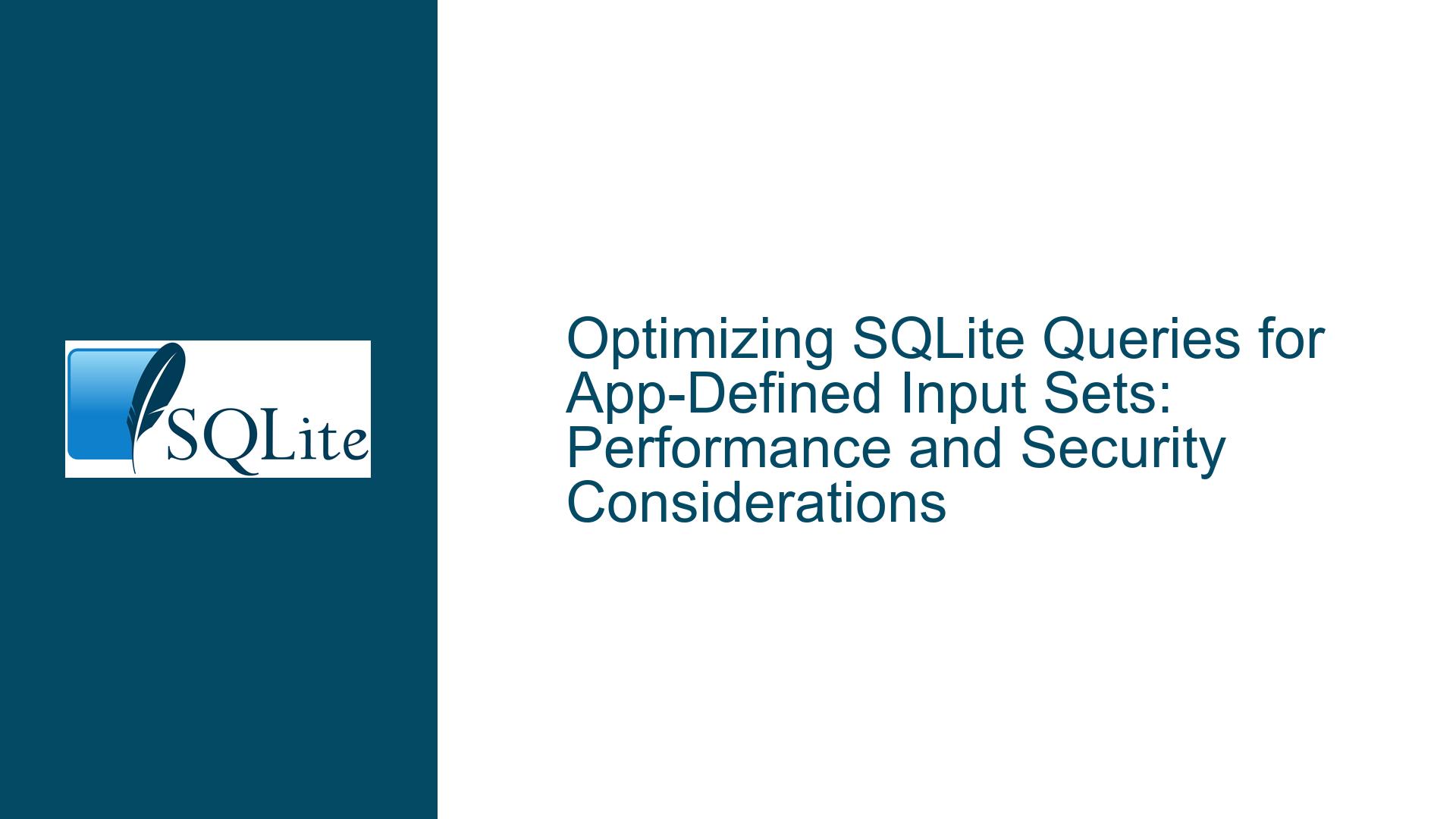Optimizing SQLite Queries for App-Defined Input Sets: Performance and Security Considerations
Understanding the Core Problem: Querying with App-Defined Input Sets
When working with SQLite in application development, a common scenario arises where you need to execute a SQL statement over a set of input values, typically primary keys, that are defined outside of the database. These values are often passed from the application layer, such as a C++ function like deleteRows(std::vector<int64_t> rowids). The challenge lies in determining the most efficient and secure way to handle these operations, especially when performance and security are critical considerations.
There are two primary approaches to this problem:
- Iterative Execution with Parameter Binding: This involves creating or reusing a prepared statement (
sqlite3_stmt) that accepts a single parameter. The application then iterates over the input values, binding each value to the statement and executing it sequentially. For example,DELETE FROM table WHERE rowid=?would be executed multiple times, once for eachrowid. - Bulk Execution with IN Clause: This approach constructs a SQL string dynamically, embedding all input values within an
INclause. For example,DELETE FROM table WHERE rowid IN (1, 4, 27, 950, 32, 17, 666, 999). The statement is compiled and executed once, with all values processed in a single pass.
The core question is: Which approach is faster and more efficient? To answer this, we need to delve into the nuances of SQLite’s internal mechanisms, including query compilation, execution engine overhead, and index utilization. Additionally, we must consider the security implications of each approach, particularly the risk of SQL injection attacks.
Analyzing Performance and Security Trade-offs
Iterative Execution with Parameter Binding
The iterative approach involves executing a prepared statement multiple times, each time with a different parameter value. This method has several characteristics:
- Query Compilation Overhead: The SQL statement is compiled only once, reducing the overhead associated with parsing and compiling the query multiple times.
- Execution Engine Overhead: Each execution requires entering and exiting the SQLite bytecode interpreter, which introduces some overhead. However, this overhead is generally minimal for simple queries.
- Index Utilization: Since each execution is independent, SQLite must traverse the B-tree index from the root for each query. This can lead to repeated index lookups, which may be inefficient for large datasets.
- Security: This approach is inherently immune to SQL injection attacks because the input values are bound as parameters, ensuring they are treated as data rather than executable SQL code.
Bulk Execution with IN Clause
The bulk execution approach constructs a single SQL statement with an IN clause that includes all input values. This method has its own set of characteristics:
- Query Compilation Overhead: The SQL statement is dynamically constructed and must be parsed and compiled each time it is executed. This can introduce significant overhead, especially for large input sets.
- Execution Engine Overhead: The statement is executed only once, with the interpreter running in a loop to process all values. This reduces the overhead associated with entering and exiting the interpreter multiple times.
- Index Utilization: SQLite can optimize the
INclause by sorting the input values and performing a single index traversal. This can be more efficient than multiple independent lookups, particularly for large datasets. - Security: This approach is vulnerable to SQL injection attacks if the input values are not properly sanitized. Constructing SQL strings dynamically can expose the application to malicious input that alters the intended query.
Exploring Alternative Solutions and Best Practices
Given the trade-offs between performance and security, it’s essential to explore alternative solutions that can provide the best of both worlds. Here are some strategies to consider:
Using Temporary Tables for Bulk Operations
One effective approach is to use a temporary table to store the input values, then perform a bulk operation using a join or subquery. This method combines the efficiency of bulk operations with the security of parameter binding. Here’s how it works:
- Create a Temporary Table: Define a temporary table to hold the input values. For example,
CREATE TEMP TABLE temp_ids (id INTEGER PRIMARY KEY);. - Insert Input Values: Insert each input value into the temporary table using parameterized queries. For example,
INSERT INTO temp_ids (id) VALUES (?);. - Perform Bulk Operation: Execute a single SQL statement that references the temporary table. For example,
DELETE FROM main_table WHERE id IN (SELECT id FROM temp_ids);.
This approach minimizes query compilation overhead while leveraging SQLite’s ability to optimize bulk operations. It also maintains security by using parameterized queries for inserting input values.
Leveraging the Carray Extension
SQLite provides an extension called carray that allows you to pass an array of values directly into a SQL query. This extension is particularly useful for scenarios where you need to perform operations on a set of input values. Here’s how to use it:
- Load the Carray Extension: Ensure the
carrayextension is loaded in your SQLite environment. - Define the Input Array: Use the
carrayfunction to pass the input array to the query. For example,DELETE FROM main_table WHERE id IN (SELECT value FROM carray(?));. - Bind the Input Array: Bind the input array to the query parameter, ensuring that the values are treated as data rather than executable SQL code.
The carray extension provides a clean and efficient way to handle bulk operations without the need for temporary tables or dynamic SQL construction. It also maintains security by using parameter binding.
Benchmarking and Performance Testing
Given the complexity of performance optimization, it’s crucial to conduct benchmarking and performance testing to determine the most effective approach for your specific use case. Here are some steps to follow:
- Define Test Scenarios: Create test scenarios that reflect real-world usage patterns, including varying input set sizes, table sizes, and index configurations.
- Measure Execution Time: Use SQLite’s built-in timing functions or external profiling tools to measure the execution time of each approach.
- Analyze Query Plans: Use the
EXPLAIN QUERY PLANstatement to analyze the query execution plan and identify potential bottlenecks. - Iterate and Optimize: Based on the results, iterate on your approach, making adjustments to optimize performance while maintaining security.
Conclusion: Balancing Performance and Security in SQLite Queries
When dealing with app-defined input sets in SQLite, the choice between iterative execution and bulk execution depends on a variety of factors, including the size of the input set, the complexity of the query, and the need for security. While iterative execution with parameter binding offers robust security and minimal query compilation overhead, bulk execution with an IN clause can provide significant performance benefits for large datasets.
Alternative solutions, such as using temporary tables or leveraging the carray extension, offer a balanced approach that combines efficiency with security. Ultimately, the best practice is to conduct thorough performance testing and analysis to determine the optimal strategy for your specific use case. By understanding the nuances of SQLite’s internal mechanisms and exploring alternative solutions, you can ensure that your queries are both fast and secure.






